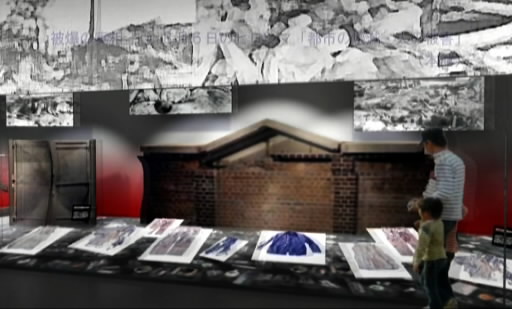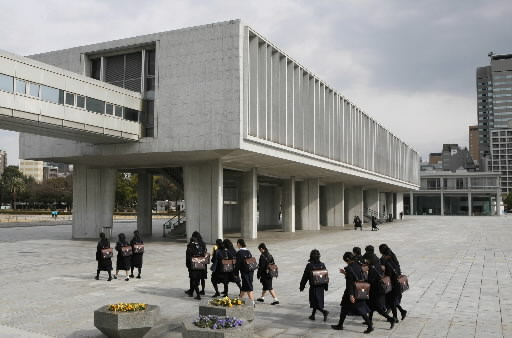Hiroshima Peace Memorial Museum to undergo major renovations starting in fiscal 2013
Feb. 15, 2013
by Michiko Tanaka, Staff Writer
Major renovations to Hiroshima Peace Memorial Museum will begin in fiscal 2013. The renovation work on the facility, designated an important cultural property by the Japanese government, is expected to last five years. The project, the largest renovation effort since the museum opened its doors in 1955, will include seismic retrofitting of the Main Building and is budgeted at 5.7 billion yen. The City of Hiroshima is planning to renew the exhibition content and the route for touring the museum to enable visitors to gain a deeper understanding of the horrific consequences of the atomic bombing, which instantly annihilated the city. The museum will be fully open again in April 2018.
The renovation work will begin in the East Building, where the entrance to the museum is located. The Main Building, which was designed by Kenzo Tange (1913-2005), has been deemed an important cultural property. This building, constructed almost 60 years ago, is now aging and in need of full-scale seismic reinforcement. The municipal government has been in discussion with the Agency for Cultural Affairs regarding the renovation methods in order to preserve the exterior of the building. In fiscal 2013, samples will be taken from the outer walls and columns to examine their degree of deterioration.
On February 7 the city released the initial budget for fiscal 2013, from its general account, allocating 43 million yen to cover the costs of the renovation work and inspection of both buildings.
Along with the seismic retrofitting, a renewal of the exhibits is planned. The new exhibition content is expected to better convey to younger generations the horrific devastation caused by the atomic bombing, which destroyed the city and wreaked havoc in the lives of its residents. The Main Building will focus on the consequences of the atomic bombing, while the East Building will offer information on Hiroshima’s reconstruction and its history of pursuing nuclear abolition and a peaceful world. New additions will include combined displays of A-bomb-related materials and a panoramic model on which views of the city, before and after the bombing, will be projected.
The tour route through the museum will also change substantially. The exit will be moved to the East Building, where the entrance is located. After entering, visitors will go to the third floor via a newly-installed escalator, look at the panoramic model, then head to the Main Building, where the A-bomb materials will be displayed. The Main Building will also contain more materials on the effects of radiation, a decision made following the accident at the Fukushima No. 1 (Daiichi) nuclear power plant.
Visitors will then return to the East Building, to the second and third floors, where they can learn about the reconstruction of the city after the bombing and the damage caused by radiation in places around the world.
The buildings will be closed, in turn, during the renovation work. The East Building will be closed in phases from fiscal 2014 and reopen fully in fiscal 2016, before the renovation of the Main Building begins. The Main Building will be closed in fiscal 2016 and 2017, but will be open in fiscal 2015 for the 70th anniversary of the atomic bombing, which is expected to draw a large number of visitors to the city.
(Originally published on February 8, 2013) An example of a combined display of A-bomb materials planned for the Main Building of Hiroshima Peace Memorial Museum. (Computer-generated image provided courtesy of the museum) Hiroshima Peace Memorial Museum, located in Naka Ward, Hiroshima, will undergo full-scale renovations. In the center is the museum’s Main Building, and to the right is the East Building.
Major renovations to Hiroshima Peace Memorial Museum will begin in fiscal 2013. The renovation work on the facility, designated an important cultural property by the Japanese government, is expected to last five years. The project, the largest renovation effort since the museum opened its doors in 1955, will include seismic retrofitting of the Main Building and is budgeted at 5.7 billion yen. The City of Hiroshima is planning to renew the exhibition content and the route for touring the museum to enable visitors to gain a deeper understanding of the horrific consequences of the atomic bombing, which instantly annihilated the city. The museum will be fully open again in April 2018.
The renovation work will begin in the East Building, where the entrance to the museum is located. The Main Building, which was designed by Kenzo Tange (1913-2005), has been deemed an important cultural property. This building, constructed almost 60 years ago, is now aging and in need of full-scale seismic reinforcement. The municipal government has been in discussion with the Agency for Cultural Affairs regarding the renovation methods in order to preserve the exterior of the building. In fiscal 2013, samples will be taken from the outer walls and columns to examine their degree of deterioration.
On February 7 the city released the initial budget for fiscal 2013, from its general account, allocating 43 million yen to cover the costs of the renovation work and inspection of both buildings.
Along with the seismic retrofitting, a renewal of the exhibits is planned. The new exhibition content is expected to better convey to younger generations the horrific devastation caused by the atomic bombing, which destroyed the city and wreaked havoc in the lives of its residents. The Main Building will focus on the consequences of the atomic bombing, while the East Building will offer information on Hiroshima’s reconstruction and its history of pursuing nuclear abolition and a peaceful world. New additions will include combined displays of A-bomb-related materials and a panoramic model on which views of the city, before and after the bombing, will be projected.
The tour route through the museum will also change substantially. The exit will be moved to the East Building, where the entrance is located. After entering, visitors will go to the third floor via a newly-installed escalator, look at the panoramic model, then head to the Main Building, where the A-bomb materials will be displayed. The Main Building will also contain more materials on the effects of radiation, a decision made following the accident at the Fukushima No. 1 (Daiichi) nuclear power plant.
Visitors will then return to the East Building, to the second and third floors, where they can learn about the reconstruction of the city after the bombing and the damage caused by radiation in places around the world.
The buildings will be closed, in turn, during the renovation work. The East Building will be closed in phases from fiscal 2014 and reopen fully in fiscal 2016, before the renovation of the Main Building begins. The Main Building will be closed in fiscal 2016 and 2017, but will be open in fiscal 2015 for the 70th anniversary of the atomic bombing, which is expected to draw a large number of visitors to the city.
(Originally published on February 8, 2013) An example of a combined display of A-bomb materials planned for the Main Building of Hiroshima Peace Memorial Museum. (Computer-generated image provided courtesy of the museum) Hiroshima Peace Memorial Museum, located in Naka Ward, Hiroshima, will undergo full-scale renovations. In the center is the museum’s Main Building, and to the right is the East Building.









